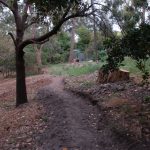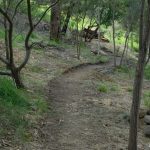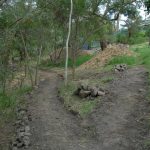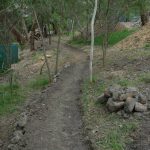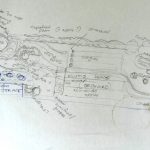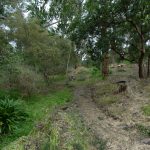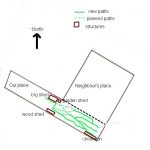Well, this entry might be called ‘Paths’, but it could just as easily have been ‘Vision’, ‘Inspiration’, or ‘Design’. I certainly have a vision for this new garden. It’s divided into two areas lengthwise – the lower section along the southern fence line, and the upper two thirds. The upper area will become a productive garden, but it must look beautiful too. No straight lines; instead, flowing curves following terrain. As well as conventional vegies, I want herbs, berries, flowers, sculpture, espaliered fruit and unusual accent plants, such as a golden bay tree, Laurus nobilis ‘Aurea’, and miniature pear ‘Trixzie’. Potager isn’t exactly right, because that suggests a slightly more formal, geometric layout, but its function will be that of a beautiful kitchen garden.
Once I realised the lower third already included many thriving Australian plants, I decided to enhance the native and endemic (native to the local area) understorey. As well, I’ll pop in a few native food species – native finger lime, Citrus australasica, macadamias, plus exotic species that thrive in dappled shade and will look in place, such as jaboticaba, Myrciaria cauliflora.
The inspiration for the native section is two-fold. Although I’m annoyed by those who insist that every plant in everyone’s garden should be endemic, I agree that encouraging sustainability – at any level – benefits us all. If every garden in Adelaide had just one or two endemic plants we’d instantly create additional habitat for numerous species of birds and insects. Adelaide gardeners will find plenty of ideas here (then click on the demonstration site trail link). Second, native habitat encourages insect-eating birds, predator insects and lizards, all of which will pop into my vegie patch to fight pests.
For the productive area, my inspiration is my grandparents, who were keen gardeners, as well as my mother, who still maintains a lovely garden in suburban Adelaide.
In twenty years of garden journalism, I’ve interviewed only one gardener whose passion was not sparked in childhood by a close relative; the exception was an immigrant whose love of growing food arose from deprivations during World War 2. My own Opa and Oma went through that war too, and emigrated from Holland to Australia in the fifties. Their quarter hectare suburban block produced fruit, vegetables, nuts, honey and eggs; my grandmother bottled fruit and made jams. I lived with them for the first seven years of my life and I have wonderful memories of the garden: wheelbarrow rides, picking peas (and eating them!) and planting watercress to spell, ‘Helen’.
They subsequently moved to a hobby farm in the Adelaide Hills, where they developed a half hectare plot for strawberries, currants, bramble fruits as well as vegies; they also had a fruit and nut orchard. My grandmother created a beautiful native garden long before it became fashionable because she loved the birds it attracted. After my grandfather retired from his professorship, he sold honey, eggs and other produce from a profitable little roadside stall. The picture shows me at the site of their vegie garden before it was established; my grandmother, very uncharacteristically, has grown a patch of dahlias.
Every holiday, from early teens onwards, my best friend and I spent the better part of each school break on the property, at first just playing, but then working full time in the garden. We packed berries for my grandfather’s stall, learned my grandmother’s jam recipes, and shelled almonds.
After the Ash Wednesday bushfire, which melted downpipes and exploded windows as my grandparents crawled from room to room dousing flames – a psychologically scarring experience – they returned to the suburbs and established their last garden on a standard block. The front yard began as lawn edged by garden beds, but every year the beds expanded until only narrow lawn paths were left, at which point my grandmother admitted grass wasn’t her favourite and spread bark chips! Of course, the back garden still housed chooks, fruit trees and vegetables – no family member ever left empty-handed.
When my grandparents grew increasingly frail, my eldest teenage daughter maintained their garden. And at the end, after my grandfather had died and my grandmother was bedridden, my daughter planted a spectacular display of annuals visible from my Oma’s bedroom window – sadly, she passed away before they bloomed. She would have loved the display, but I’m sure that my daughter’s presence all those days, their conversations and companionship, would have been the most precious thing.
Anyway, I watched my Opa and Oma create two of their gardens from scratch and, when I moved into my Crafers property twenty six years ago, I established my own ornamental garden. I’ve mentioned there wasn’t enough sun for many vegies but I’ve always grown currants, cutting grown from my grandmother’s original plants. But I hadn’t realised until seeing old photographs just how much of my design reflected my grandparents’ gardens – the spacing and curves of my slate paths are almost identical to one of my grandmother’s.
So what about the design of the new area? After my neighbour and I agreed on the deal, I drew many plans on paper but, after I began on the blackberries, most of the plans went out the window. I realised I needed two design priorities.
The first priority is access. I’m as sprightly as a mountain goat, but I want the garden to be equally accessible when I’m in my late seventies… or older! On a sloping block, this means all paths must have gentle gradients, and I’ll avoid steps wherever possible. If I do build steps, there must be an alternative path without steps to access the same area.
In those three months of removing blackberries, natural walkways emerged. I also knew where we’d put the woodshed and chicken coop, and that they’d need easy access. So my first path was from the woodshed to the new chicken run.
The paths must also be reasonably wide, so a wheelbarrow (and maybe, one day, a walking frame!) will fit, and the paths will be at the base of any retaining walls – for access to raised beds, and also because, after excavation, the soil will be shallower on the uphill side (better for feet than for vegetables).
I want most of the paths to have attractive curves and to flow into one another. I designed them on the ground and laid out hoses and rocks until the curves were as I liked them before beginning construction. And because all the landscaping is being done by me, with nothing more than a pick, shovel and sweat, modest terracing is fine, but major re-contouring is not.
The plan with the green lines shows interlocking leaf shapes and curved wedges rather than the traditional rectangular beds as I envisioned, like the fingers of an E.T. hand. The dotted green lines are where I think the paths will go… but I’m still unsure. At the moment, the paths at the eastern end of the block have been excavated and walled, but they stop in the middle of nowhere at the western end! When the Canary Island pine goes, I’ll know exactly where the paths need to lead, and I’ll finish them then. So far, I’ve gotten away with just two steps, and I’m hoping I won’t need more.
The second priority is sunlight. All planting must maximise and preserve light reaching the area: what goes where will be essential as fruit trees grow, so:
1. Plant no tall evergreens on the northern or north-western areas (any trees, such as citrus, must be kept below 2m);
2. Reserve areas south of existing evergreen trees for deciduous crops or summer vegies when the sun is higher in the sky
3. Preserve the most open areas for winter vegies and fruiting vegetable crops
4. Utilise areas with morning sun only (i.e. protection from hot afternoon sun) for bramble fruit, currants and leaf crops
5. Utilise dappled shade for plants like native finger lime, rhubarb and other crops that tolerate less sun.
6. Plant no tall evergreens above the chicken coop
This seems like a lot to dovetail, but I’m making no plantings* until winter 2012, and I’ve already had months of thinking time (plus that all-important garden time, seeing exactly where the sunlight falls at different times of the year). By the time I’m ready to plant my first trees, I’ll have had nearly a year of observations, so I’m confident I’ll get it right.
*Well, about those plantings, I confess: I’m holding firm on the permanent plantings (almost!), and I was going to avoid planting anything at all but, as I established the first fallow beds, I couldn’t resist just a few summer vegies – spuds, tomatoes, chillies and basil. But I’m sure all of you reading or listening to this will completely understand!
#gallery-1 {margin: auto;}#gallery-1 .gallery-item {float: left;margin-top: 10px;text-align: center;width: 33%;}#gallery-1 img {border: 2px solid #cfcfcf;}#gallery-1 .gallery-caption {margin-left: 0;}/* see gallery_shortcode() in wp-includes/media.php */